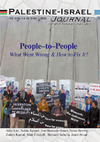Editorial
Israel declared since 2002 that it will adopt a unilateral steps
policy in the Palestinian Occupied Territories, alleging that
"there is no one to talk to." This approach has failed in the Gaza
Strip, proving that unilateral actions cannot be conducive to
peace. Real peace can only come through negotiations and bilateral
steps.
Recent political developments in Palestine and Israel proved that
people-to-people activities between Palestinian and Israeli civil
societies have become more important than ever. Efforts to rebuild
trust and open channels of communication between the two peoples on
the road to peace must be continued.
Peace agreements between two governments can be reached, but
further steps are needed for peace to filter down to the
population. Progress on the political track contributes to the
success of people-to-people activities and the reverse is also
true.
The failure of the peace talks and the outbreak of the al-Aqsa
intifada in September 2000 caused a setb
read more ...
